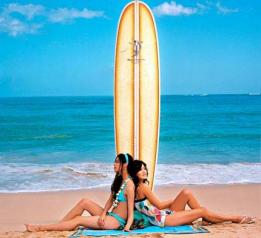Part 1 A Brief Introduction to Hawaii 夏威夷群島簡介
The Hawaiian island chain began around 10 billion years ago with the form ation of Kauai and Niihau. The islands are a result of the movement of the Pacific Plate, one of Earth's tectonic plates, over a hot spot. A hot spot is a place where molten rock escapes through the crust, like a volcano.
Eventually, the build-up of magma from the ocean floor will reach sea level to create an island. Over time, the hot spot will die down as the Pacific Plate continues to move. This movement offers a new place to create another island if the hot spot returns to activity.
Over thousands of years, the hard lava rock deteriorates, allowing for plants to thrive and animals to survive.
The natives of the Hawaiian Islands came from clusters of people referred to presently as Polynesians. Polynesians originated from Southeast Asia, but their history cannot be completely traced. They were great navigators and settled numerous islands in the Pacific Ocean, from New Zealand to Easter Island and Hawaii, the most northern and last to be settled. This expansive area of islands is called the Polynesian Triangle.
The Hawaiian Islands were again discovered by Captain James Cook of England in 1778. About a year later in 1779, Cook returned to Hawaii only to create a series of misfortunate incidents - events, which led to his untimely death at the hand of natives. The warring state of the islands at the time of Cook's arrival did not help the circumstance. Hawaii was more or less divided into three kingdoms at Cook's advent. King Kamehameha, who was present at Cook's visits, worked hard to unite all the islands of Hawaii under one rule by 1810.
King Kamehameha's death marked the decline of the kapu system and many other traditional values. These values were manipulated by Christian missionaries, who sought to save what they considered the heathen souls of the natives. The first boat of missionaries arrived in 1820 and by 1823 the first mission was founded in Lahaina. It wasn't long before many natives converted to Christianity. The greatest threat to the missionary effort was not locals, but the whale and merchant ships. These ships brought drunken and lustful men. Lahaina was the busiest port of the area during this time. It would be Hawaii's present capitol, but Kamehameha III ultimately moved it to Honolulu.
Landownership was a foreign concept to native Hawaiians. Efforts were attempted by Kamehameha III to divide the land and make it possible to formally acquire it. This system and the natives' inexperience were abused by whites. Since that decree, Hawaiian lands have swiftly fallen to foreigners. Many Europeans set up plantations on their newly stifled land to grow sugar cane and pineapple. However, there was not enough local labor due to disease brought by outsiders. By the 1850s, the native population was reduced to one fifth.
The last of the Hawaiian monarchs was Lydia Liliuokalani, who was of royal blood but not of Kamehameha lineage. Her reign began in 1891 and was short lived. It ended in 1893 as a result of a coup supported by sugar growers and undoubtedly the U.S. government. A new provisional government was put into place. Most natives were prevented from voting and were powerless against the U.S.' ultimate goal of annexation in 1898.
The military became as significant to Hawaii as Hawaii was central to the military. The military took over the economy providing money and jobs. As a result of the bombing of Pearl Harbor on December 7, 1941, more mainlanders considered Hawaii perpetually bound to the U.S. More locals also considered themselves American and created a greater movement for statehood. It took several years for Hawaii to become the 50th state in 1959.
The 1960s brought about the era of the tourists through the revolution of the passenger airplane. Today, more than 6 million visitors per year come to Hawaii to bask in the aloha spirit of the islands.

夏威夷群島的天然環境非常迷人,屬于火山島,地形崎嶇不平;擁有美麗的海灘,從白色的沙灘一直到黑色土質的沙灘都有。地形與地質的變化也非常大,不論從低地沙漠一直到高聳的山頂,或是從貧瘠的火山巖到熱帶雨林區,在夏威夷群島上,通通都看得到。
夏威夷群島也是全世界位置最孤立的島群,距離最近的大陸地也有2500英哩遠。正因為這樣的孤立,也為夏威夷帶來保持生態完整的好處,在這里的上千種動植物種類,有90%以上,在地球上其它地方,已經看不到了。
這里的地質結構也是獨一無二的,這里有全世界最活躍的活火山,也有最大的死火山哈力卡拉(Haleakala);同時也有最高的摩納其山(Mauna Kea)和懸崖。這里的觀光旅游業非常發達,旅館如雨后春筍越來越多,海灘上總是擠滿了人,這不過只是夏威夷的面貌之一;你還是可以找到非觀光熱門地區,也有人少偏僻的海灘可以探險,住宿的選擇也有內陸的小屋或孤立偏遠的住處。
在島上健行或在野外地區逍遙自在的旅行,是完全不用付費的。夏威夷群島有世界頂尖的沖浪、玩風浪板地點,像瓦胡島就是全世界最棒的沖浪地;當然,游泳、潛水也是這里最熱門的水上運動。
在到夏威夷旅游度假的人們心中,最有吸引力的莫過于海濱浴場。其中最熱鬧、最聞名的是懷基基海灘,遠處碧海藍天,白云悠悠,近處椰林婆娑,金黃的沙灘,滔滔的白浪,令人感到無限的心曠神怡。
懷基基海灘以巨浪聞名,相傳當年土著國王和酋長們常在此舉行沖浪比賽,沖浪運動由此發端走向世界。
在氣候上,因為整年都有涼流吹過,所以夏威夷一年四季都非常宜人舒適;通常大白天的陣雨來得急也去得快,緊接著馬上就雨過天晴,天空中還會出現絢麗的彩虹。瓦胡島(Oahu)是群島里人口最密、發展最多的島,光是歐胡島上的旅館數,就占了全夏威夷旅館數的一半。
在檀香山 Honolulu,可以體會得到都市生活的好處與壞處,這里有很棒的博物館、活躍的夜生活,還有好吃不貴的各種美食,但也一樣免不了都市的通病-塞車。毛伊島(Maui)是僅次于瓦胡島,發展第二的島,也是賞座頭鯨的好地方。至于大島(Big Island),則有雪跟活火山,兩樣在夏威夷其它島上所沒有的地理特色;考愛島(Kauai)擁有全夏威夷最青綠茂密的植物景色。
夏威夷原是一個王國,1898年被美國吞并,1959年夏威夷歸入美國版圖,成為星條旗上的第50顆星。
夏威夷群島的人民約80%是黑頭發、黃皮膚的東方人,以致給來島的游客第一個印象,仿佛是已到了東方。
第二個給人深刻印象的便是遐邇聞名的夏威夷衫,那色調鮮艷而濃郁的襯衫正配合著夏威夷亮麗熱烈的南海風光。而當地婦女套穿的拖地長裙,既無曲線,又無紐扣,但卻格外顯得舒適和瀟灑,而更具風情。
Part 2 Have Fun at Hawaii 暢游夏威夷
Dialogue Script 1 對話原文 1
Lisa: Aloha! I have a lei to welcome you to paradise.
Ben: Huh? I don't see any cuties around.
Lisa: No, silly! Not that kind of "lay". This lei is a necklace made of Hawaiian flowers!
Ben: Thanks. I was just kidding, you know. The islands look so beautiful from the air.
Lisa: And they look even more lush from the ground.
Ben: Well, after the Mormon Utah desert, I can use as much as lushness as I can get.
講解:
1. 對話中,Lisa在機場迎接Ben的到來,Ben是到夏威夷來度假的。見到了Ben,Lisa熱情地說了一聲,Aloha!這是夏威夷土著的語言,不管見面問好還是說再見的時候都可以用到,夏威夷州的別名,Aloha State也因此而得名。
2. Lisa說,I have a lei to welcome you to paradise. 我帶了一個可愛的東西來歡迎你到天堂。這里的paradise就是指夏威夷了。lei是指“花環”,當你乘著飛機抵達檀香山,通常一走出機場,就會看見熱情的夏威夷女郎喊著Aloha,手里拿著一串花環,lei,往游客的脖子上套,不過這些lei可是要付費才能帶走的紀念品哦。
3. 但是Ben故意打岔,把lei聽成了lay,這個詞,l-a-y,發音跟l-e-I是一樣的,但是兩個詞的意思可是相差十萬八千里,lay是指“性伴侶”,而不是指帶在脖子上的夏威夷花環。所以Ben跟Lisa開玩笑說,我怎么沒看見你身邊有漂亮姑娘啊。cutie是cute的名詞形式,表示“可人,長的漂亮的人”。
4. Lisa罵Ben是小笨蛋,不是那種“女伴”,而是這種用夏威夷花卉做成的項鏈。Ben趕忙道謝,并解釋說,自己是在開玩笑呢。Ben贊嘆說,從飛機上看夏威夷群島真是漂亮極了。Lsia說夏威夷群島從地上看也是綠意盎然。lush這個詞表示“蒼翠的”,名詞形式是lushness,表示“翠綠”。
5. Ben聽了很高興,說在經歷了摩門尤他州的沙漠之后,再多的綠意我也不嫌多。I can use...這個句型表示“我需要...”,比如說,Now I can use some cash. 現在我需要一些現鈔。











